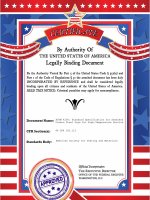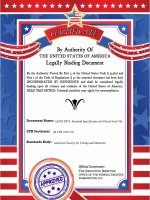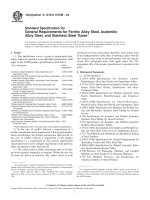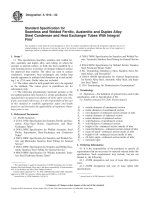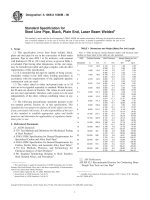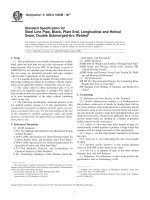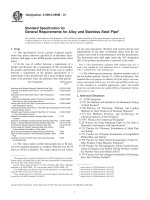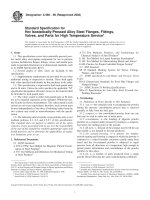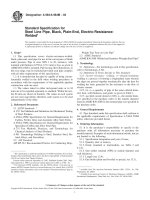ASTM D209-81 (2023) Standard Specification for Lampblack Pigment
Bạn đang xem bản rút gọn của tài liệu. Xem và tải ngay bản đầy đủ của tài liệu tại đây (194.94 KB, 2 trang )
This international standard was developed in accordance with internationally recognized principles on standardization established in the Decision on Principles for the
Development of International Standards, Guides and Recommendations issued by the World Trade Organization Technical Barriers to Trade (TBT) Committee.
Designation: D209 − 81 (Reapproved 2023)
Standard Specification for
Lampblack Pigment1
This standard is issued under the fixed designation D209; the number immediately following the designation indicates the year of
original adoption or, in the case of revision, the year of last revision. A number in parentheses indicates the year of last reapproval. A
superscript epsilon (´) indicates an editorial change since the last revision or reapproval.
This standard has been approved for use by agencies of the U.S. Department of Defense.
1. Scope received it shall not be caked in the container, and shall break
up readily in oil to form a smooth paint of brushing consis-
1.1 This specification covers the pigment commercially tency. It shall mix readily in all proportions, without curdling,
known as lampblack. The pigment may be purchased in the dry with linseed oil, turpentine, or volatile petroleum spirits, or any
form or as a paste in oil. mixture of these substances. The paste shall conform to the
following requirements:
1.2 This international standard was developed in accor-
dance with internationally recognized principles on standard- Pigment, min, % 25
ization established in the Decision on Principles for the
Development of International Standards, Guides and Recom- Linseed oil, max, % 75
mendations issued by the World Trade Organization Technical
Barriers to Trade (TBT) Committee. Moisture and other volatile matter, max, % 0.7
Coarse particles and skins (total residue retained on a 1.0
45-µm (No. 325) sieve), max, % of the dry pigment
2. Referenced Documents 3.3 The mass color and character of the tint and the tinting
strength formed by a mixture with a white pigment shall be
2.1 ASTM Standards:2 within mutually agreed- upon limits of a standard acceptable to
D185 Test Methods for Coarse Particles in Pigments both the purchaser and the seller.
D387 Test Method for Color and Strength of Chromatic
4. Sampling
Pigments with a Mechanical Muller
D1208 Test Methods for Common Properties of Certain 4.1 Two samples shall be taken at random from different
packages from each lot, batch, day’s pack, or other unit of
Pigments production in a shipment. When no markings distinguishing
between units of production appear, samples shall be taken
3. Composition and Properties from different packages in the ratio of two samples for each
10 000 lb (4540 kg), except that for shipments of less than
3.1 Dry Pigment—The pigment shall be made by burning 10 000 lb two samples shall be taken. At the option of the
oils or tars in such a manner as to form a deposit of carbon or purchaser, the samples may be tested separately or after
soot. It shall be high grade in every respect and shall be free blending in equal quantities the samples from the same
from oil, greasy matter, and admixture of any other substance. production unit to form a composite sample.
The pigment shall conform to the following requirements:
Ash, max, % 0.5 5. Test Methods
Acetone extract, max, % 1.0
Moisture and other volatile matter, max, % 3.0 5.1 Tests shall be conducted in accordance with the follow-
Coarse particles, (total residue retained on a 0.5 ing test methods. Test procedures not covered by ASTM test
methods shall be mutually agreed upon between the purchaser
45 µm (No. 325) sieve), max, % clear-blue-gray and the seller.
Tone when diluted with zinc oxide
5.2 Coarse Particles—Test Methods D185.
3.2 Paste in Oil—The paste in oil shall be made by
thoroughly grinding the specified pigment with linseed oil. As 5.3 Pigment, Linseed Oil, and Moisture and Other Volatile
Matter in Paste in Oil—Test Methods D1208.
1 This specification is under the jurisdiction of ASTM Committee D01 on Paint
and Related Coatings, Materials, and Applications and is the direct responsibility of 5.4 Mass Color and Tinting Strength—Test Method D387.
Subcommittee D01.31 on Pigment Specifications.
6. Keywords
Current edition approved June 1, 2023. Published June 2023. Originally 6.1 carbon; lampblack; linseed oil; pigment; soot
approved in 1924. Last previous edition approved in 2019 as D209 – 81 (2019).
DOI: 10.1520/D0209-81R23.
2 For referenced ASTM standards, visit the ASTM website, www.astm.org, or
contact ASTM Customer Service at For Annual Book of ASTM
Standards volume information, refer to the standard’s Document Summary page on
the ASTM website.
Copyright © ASTM International, 100 Barr Harbor Drive, PO Box C700, West Conshohocken, PA 19428-2959. United States
1
D209 − 81 (2023)
ASTM International takes no position respecting the validity of any patent rights asserted in connection with any item mentioned
in this standard. Users of this standard are expressly advised that determination of the validity of any such patent rights, and the risk
of infringement of such rights, are entirely their own responsibility.
This standard is subject to revision at any time by the responsible technical committee and must be reviewed every five years and
if not revised, either reapproved or withdrawn. Your comments are invited either for revision of this standard or for additional standards
and should be addressed to ASTM International Headquarters. Your comments will receive careful consideration at a meeting of the
responsible technical committee, which you may attend. If you feel that your comments have not received a fair hearing you should
make your views known to the ASTM Committee on Standards, at the address shown below.
This standard is copyrighted by ASTM International, 100 Barr Harbor Drive, PO Box C700, West Conshohocken, PA 19428-2959,
United States. Individual reprints (single or multiple copies) of this standard may be obtained by contacting ASTM at the above
address or at 610-832-9585 (phone), 610-832-9555 (fax), or (e-mail); or through the ASTM website
(www.astm.org). Permission rights to photocopy the standard may also be secured from the Copyright Clearance Center, 222
Rosewood Drive, Danvers, MA 01923, Tel: (978) 646-2600; />
2
